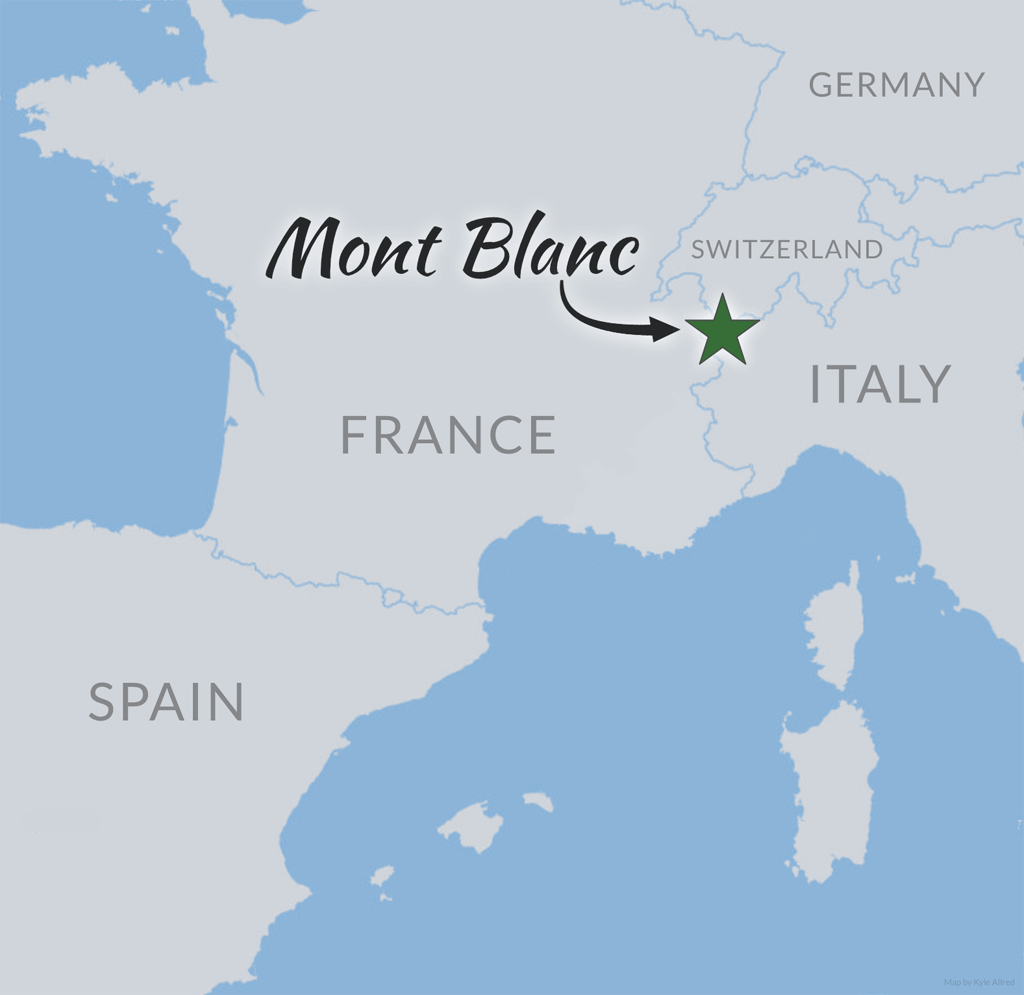
Mont Blanc
Today we travel to the border of France and Italy, to the crown of the Alps.
The highest point in that famed mountain range and all of Western Europe is Mont Blanc. Meaning “white mountain” in French, the crag’s Italian name is Monte Bianco. Rising 15,774 feet above sea level, both countries claim the peak resides within their borders. Over the years, decades, and centuries, some publications labeled the apex in France, some in Italy, and some simply put it on the border.
Since our opinion matters immensely, we’ll be diplomatic and give it to both wonderful nations.

Mont Blanc is the second-highest mountain in Europe and one of the most prominent peaks in the world, ranking 11th in that measure. The mountain is the queen of an eponymous portion of the western Alps, called the Mont Blanc Massif. This massif is part of a larger subrange called the Graian Alps. Stretching from the French-Italian border’s intersection with Switzerland for 29 miles, into both nations, the massif is a glaciated marvel with 11 summits over 13,000 feet.
Though Mont Blanc and the alpine region have long attracted the gaze of humans, no serious attempt to climb the mountain occurred before the 1770s. Not until 1786 did the first recorded ascent transpire, as Jacques Balmat and Michel Paccard successfully stepped upon the apex. Just over 20 years later, in 1808, the first woman, Marie Paradis, reached the top of the Alps. An incredible accomplishment for the norms of the time. She will, I’m sure, one day find herself within the hallowed halls of Woman Crush Wednesday here at TMAC HQ.


By the end of the 19th century, mountaineers and scientists were keen to explore the peak and the massif. These pursuits helped usher in a wonderful feature of European mountains: permanent structures at high altitudes.
Botanist and meteorologist Joseph Vallot constructed a permanent cabin about 1,500 feet below the summit. Astronomer Peter Janssen enlisted Gustave Eiffel to build an observatory at the summit. The famed architect agreed if he could work from solid rock. Two 75-foot horizontal tunnels through the ice, at a depth of nearly 40 feet failed to find stone, so Eiffel abandoned the task. Janssen pressed on, completing an observatory rooted in the ice in 1893. By the first decade of the 20th century, the building was doing a Leaning Tower of Pisa impression and fell into a crevasse that opened beneath it in 1909.
Still, observation points and “cabins” exist all over the Alps. Some of these buildings boggle the mind, based on their locations and the engineering that must have accompanied them. Along with cable-powered transportation, tourists can reach much higher points without strenuous hiking than they usually realize. Of course, reaching the peak of Mont Blanc is still no stroll through le parc.


Though climbing to the pinnacle of France and Italy usually takes two days and requires significant climbing knowledge, estimates put the number of climbers each year at around 20,000. This number suggests that Mont Blanc, while difficult, does not require as many technical skills as some other famous mountains. That notion seems to be widely accepted. However, this tri-point of tough-but-not-exorbitantly-dangerous, popularity, and high altitude renders Mont Blanc deadly. A 1994 report labeled the mountain the world’s deadliest, in terms of the number of fatalities. Other mountains have worse death-to-attempt ratios, but when it comes to sheer death totals, Mont Blanc takes the title. Somewhere between 6,000 and 8,000 humans have died on the slopes. On average, 10 to 20 fatalities occur each year.
A big reason for this danger arises from a spot called the Grand Couloir. Ironically, the climbing part of the couloir is some of the easiest on the Goûter Route, the most popular and least technically demanding trail. The scrambling isn’t bad, but the rocks are another story. The Grand Couloir is a rock-fall death trap. Pebbles to boulders, the stones can come flying down the mountain at any point of the day.
You do not want to be in the couloir when they start to rain down.
Despite the risk, Mont Blanc is gorgeous and an ascent would be thrilling.
Our favorite channel, Mediocre Amateur, recently traveled to Chamonix, France, to have a go at Mont Blanc. Conditions did not allow for a summit bid, but they made it to nearby Aiguille du Midi. The video displays the resplendence of the Mont Blanc Massif.
Mont Blanc enters the bucket list!
Enjoy this video of an ascent up the Goûter Route in better conditions:
Further Reading and Exploration
Climbing Mont Blanc – Chamonix Net
Mont Blanc webcam – See Chamonix
Why Is Mont Blanc One of the World’s Deadliest Mountains? – The Atlantic
Mont Blanc – Summitpost
Spherical Panorama of Mont Blanc Peak – Panoviewer













Pingback: Mount Doom and the Crags of Mordor – themountainsarecalling.earth